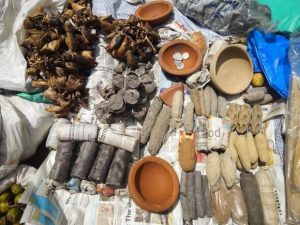What Is The Efficacy Of Herbs Embedded In Clay (Mumbwa) For Pregnant Mothers?
Traditionally In Uganda, Pregnant Women Used To Take Mumbwa And Would Deliver Normal Babies Without Any Hullabaloo.
Uganda Today: According to Dr. Eve Nakato @dr_evenakato she says there is no approved research to attest to the efficacy of a Mumbwa

However, I can provide a general analysis of the use of medicinal herbs embedded in clay or other traditional practices. The efficacy of such remedies can vary based on several factors:
- Cultural and Traditional Knowledge:
- Many communities have a rich history of using herbs and natural substances for medicinal purposes. Traditional knowledge often plays a significant role in the perceived efficacy of such remedies.
- Bioactive Compounds:
- The effectiveness of medicinal herbs depends on the presence of bioactive compounds with therapeutic properties. Some herbs contain compounds that have scientifically proven medicinal benefits.
- Scientific Research:
- While traditional knowledge is valuable, scientific research helps validate the efficacy of medicinal practices. Studies on specific herbs and their bioactive compounds can provide insights into their pharmacological effects.
- Clay as a Carrier:
- The use of clay as a carrier for medicinal herbs may have certain benefits. Clay can act as a vehicle for delivering active compounds, providing a slow-release mechanism or enhancing absorption.
- Cautions and Side Effects:
- It’s essential to consider potential side effects or interactions with other medications. Traditional remedies may not always be suitable for everyone, and consulting with healthcare professionals is advisable.
- Standardization and Quality Control:
- Standardization of herbal remedies involves ensuring consistent quality and potency. Lack of standardization can lead to variations in the effectiveness of herbal preparations.
- Regulatory Approval:
- In some regions, herbal remedies may not undergo the same rigorous testing and regulatory processes as pharmaceutical drugs. The absence of regulatory approval may raise concerns about safety and efficacy.
- Individual Variation:
- Responses to herbal remedies can vary among individuals. Factors such as genetics, underlying health conditions, and lifestyle can influence how effective a particular remedy is for a person.

Yes this is Uganda!
The beautiful Secretary Bird found in Murchison National Park
The fast Ostrich found in Kidepo Valley National Park
The Crane also known as the Crested Crane, a National Bird in Uganda mainly found in swampy areas
Uganda is famous for bird watching and a habitat of 1090 bird species
+256 702 239 337 WhatsApp
Tel +256 772 500 640
Email: cmkmediasolutions@gmail.com
*#VisitUganda*
*#Tulambule*
- Responses to herbal remedies can vary among individuals. Factors such as genetics, underlying health conditions, and lifestyle can influence how effective a particular remedy is for a person.
In conclusion, while traditional remedies, including medicinal herbs embedded in clay, may have cultural significance and anecdotal evidence supporting their efficacy, it’s crucial to approach them with a balanced perspective. Integrating traditional knowledge with scientific research and ensuring proper quality control are essential for a comprehensive understanding of their effectiveness and safety. If you’re considering using such remedies, it’s advisable to consult with healthcare professionals for personalized advice.









